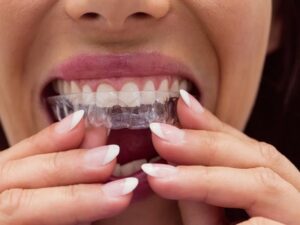Numerous oral problems, such as crooked, gapped, rotated, or crowded teeth, can be resolved with braces. Traditional metal braces, ceramic braces, and transparent aligners like Invisalign are just a few of the different kinds of braces available. The mouth is more attractive, functional, and healthy with braces.
Braces gradually move the teeth into their correct positions by applying light, continuous pressure. The specifics of how this occurs rely on the braces you select.
Orthodontists have developed a huge variety of brackets by concentrating on the wide range of preferences and financial constraints that their patients show. These various dental brackets kinds are all beneficial from one angle or another. To choose a decent option, take the budget and level of comfort into account for each type.
Types of Braces
- Invisible Braces

The teeth will be realigned using a set of aligners made of transparent plastic by Invisalign. The aligners rest on top of the teeth and resemble thin sports mouthguards. They are detachable and essentially undetectable to people around you.
While Invisalign is a good option for straightening teeth, it is not appropriate in more complicated cases, such as those involving an underbite and significant crowding, for instance. Additionally, Invisalign does not regularly adjust the end tooth positions as effectively as braces do. The finest orthodontic treatment for complicated cases is braces. Over time, the braces’ archwire’s constant pressure gradually shifts teeth into the desired position.
- Traditional fixed metal braces
To straighten teeth, traditional permanent metal braces combine metal brackets, archwires, and ligatures (elastic bands). The “original” braces are these. The brackets are now much smaller, less noticeable, and more pleasant to wear due to technological advancements.
- Ceramic Braces
With one exception, ceramic braces are very similar to conventional permanent metal braces. The supports are constructed of ceramic. They may be tooth-colored or clear, depending on the sort of ceramic bracket you select, which makes them less noticeable. Additionally smoother and more durable than conventional brace brackets are ceramic brackets.
- Self-Ligating Braces
With self-ligating braces, the archwire can move in reaction to the teeth due to brackets with a sliding mechanism. As a result, they work with significantly less friction and don’t require the elastic bands found on conventional braces. The most widely used set of self-ligating braces is the Damon method.
- Lingual braces
The teeth’s lingual surfaces are where lingual orthodontics are affixed. Lingual braces have advantages beyond just being aesthetically pleasing, including a lower danger of decalcification. This is due to the teeth’s interior area, which is stronger.
Choosing the best course of treatment at Aroma Dental is typically a joint choice. Most people require assistance from others to make the best decision. Following an examination, the orthodontist can advise on the choices. Inform the orthodontist of any preferred therapy options and get their advice.
Conclusion
Many people think that getting braces or another appliance like Invisalign aligners affixed to the teeth to help straighten them constitutes orthodontic treatment. The braces or aligners can be taken off once the teeth are aligned, leaving you with perfectly straight teeth.
